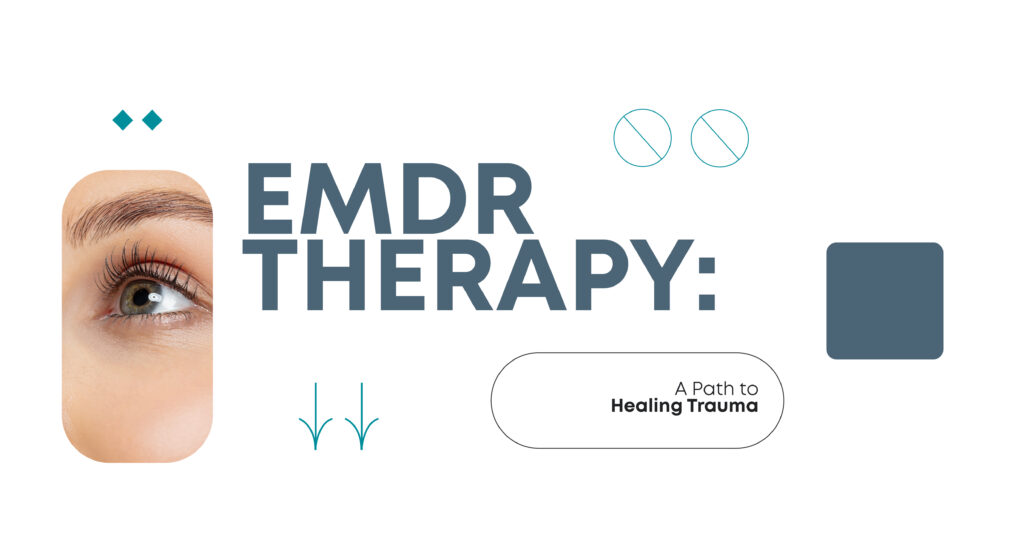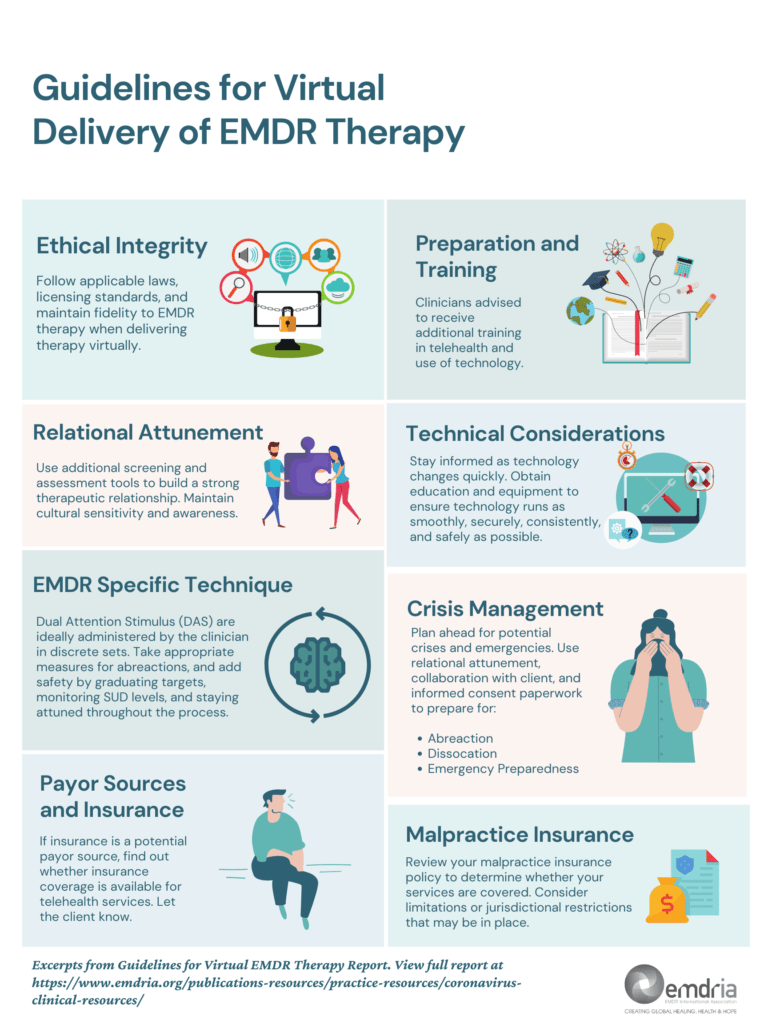How EMDR Treatment Functions: an In-depth Consider the Process and Its Performance
EMDR therapy has become a famous treatment for trauma-related disorders. Its organized strategy includes various stages designed to facilitate the handling of distressing memories. Central to this method is the principle of reciprocal stimulation, which plays an essential duty in exactly how memories are processed. Recognizing these aspects exposes much about the therapy's performance. Nonetheless, what especially takes place throughout an EMDR session, and how does it impact the therapeutic journey?
Recognizing the Principles of EMDR Treatment
EMDR therapy, or Eye Activity Desensitization and Reprocessing, operates the premise that unsolved distressing experiences can hinder psychological well-being. This ingenious therapeutic technique aims to assist in the handling of distressing memories, permitting individuals to acquire a much healthier perspective on their past. Central to EMDR is the idea of reciprocal stimulation, commonly achieved with led eye movements, which is thought to aid integrate distressing memories right into a more adaptive structure.

The 8 Stages of EMDR Therapy
The process of EMDR therapy unfolds over 8 unique phases, each designed to lead customers with a structured strategy to recovery trauma. The initial stage involves history-taking, where the specialist examines the customer's history and identifies target memories. In the 2nd phase, customers discover leisure methods to manage distress. The 3rd phase concentrates on determining negative ideas related to the stressful memory.
The 4th phase is where the desensitization procedure begins, enabling clients to process the traumatic memory. The 5th stage entails setting up favorable beliefs to change the unfavorable ones. In the 6th phase, customers are directed to assess their psychological and physical actions to the processed memory. The 7th stage highlights closure, aiding clients go back to a state of equilibrium. The 8th phase includes reevaluation, where specialists and clients examine progress and address any type of recurring distress. This complete technique fosters a path to recovery and resilience.
The Role of Reciprocal Stimulation
Reciprocal stimulation is an essential part of EMDR treatment, assisting in the handling of stressful memories. This strategy entails rotating stimulation of both hemispheres of the mind, commonly attained with eye movements, auditory tones, or tactile feelings. The purpose of reciprocal excitement is to engage the mind's all-natural information processing system, which might come to be interrupted following trauma.
By turning on both sides of the brain, reciprocal stimulation assists clients accessibility and reprocess stressful memories in a much more adaptive way. This approach encourages the combination of stressful experiences, decreasing their emotional cost and making it possible for clients to establish brand-new point of views.

Furthermore, reciprocal excitement might promote leisure and minimize anxiousness throughout sessions, creating a more secure atmosphere for clients to confront uncomfortable memories. Ultimately, this approach boosts the healing process, permitting people to move towards recovery and resolution.
Proof Sustaining the Performance of EMDR
Study has shown that EMDR therapy works in dealing with different emotional problems, especially post-traumatic stress and anxiety condition (PTSD) Various researches have shown substantial decreases in PTSD signs and symptoms adhering to EMDR therapy. A meta-analysis of randomized regulated trials located that EMDR was as effective as cognitive behavioral therapy (CBT) for PTSD, with lasting effects observed also months after treatment. Additionally, the American Psychological Organization and the Globe Health and wellness Organization back EMDR as a recommended therapy for trauma-related conditions.
Beyond PTSD, research study shows that EMDR can additionally profit people experiencing anxiety, clinical depression, and anxieties. A growing body of proof supports its usage in varied populations, consisting of children and professionals - licensed emdr therapists nyc. In general, the accumulating study emphasizes EMDR's potential as a functional therapeutic alternative, leading the way for further exploration right into its systems and applications in mental wellness treatment
What to Anticipate During an EMDR Session
Throughout an EMDR session, customers can expect a structured yet versatile approach focused on processing traumatic memories. The therapist starts by developing a secure environment, where clients can really feel comfy sharing their experiences. Initial conversations concentrate on identifying details memories and linked adverse ideas.
Clients visit the website are guided to pop over to this web-site concentrate on these memories while all at once participating in bilateral excitement, generally through directed eye activities or tapping. This double focus aims to promote the processing of the injury, enabling clients to reframe their experiences and minimize psychological distress.
Throughout the session, specialists monitor clients' actions, adjusting the speed and technique as needed. Sessions may consist of leisure methods or cognitive restructuring to reinforce positive beliefs. Generally, customers can anticipate an encouraging environment that encourages self-exploration and recovery, inevitably resulting in a better sense of psychological well-being.
Frequently Asked Questions
Is EMDR Treatment Ideal for Children or Adolescents?
EMDR therapy can be appropriate for children and adolescents, gave it is adjusted to their developing needs (emdr therapy). Medical professionals usually change strategies to ensure safety and security and performance, supporting younger populaces in processing injury and psychological distress
The Length Of Time Does EMDR Therapy Usually Last?
EMDR therapy normally lasts in between 8 to 12 sessions, with each session ranging from 60 to 90 mins. Specific demands and the intricacy of injury can affect the general duration of treatment.
Can EMDR Therapy Be Done Remotely or Online?
EMDR treatment can indeed be carried out remotely or online. Numerous professionals have adjusted their methods to virtual environments, permitting customers to participate in reliable sessions from the convenience of their homes, maintaining healing advantages.
What Are the Prospective Negative Effects of EMDR?
Possible side results of EMDR treatment may consist of short-lived psychological distress, enhanced anxiety, dazzling memories, and physical pain. People could also experience tiredness or migraines following sessions, as the mind processes extreme feelings and memories.
Exactly How Does EMDR Compare to Typical Talk Therapy?

EMDR therapy, or Eye Activity Desensitization and Reprocessing, runs on the premise that unresolved terrible experiences can hinder psychological well-being. The procedure of EMDR browse around this web-site therapy unravels over eight unique stages, each created to lead customers through an organized method to healing injury. Bilateral excitement is a necessary component of EMDR therapy, promoting the processing of distressing memories. During an EMDR session, clients can expect an organized yet adaptable method aimed at handling distressing memories. Possible side impacts of EMDR treatment may include short-term psychological distress, heightened stress and anxiety, dazzling memories, and physical discomfort.